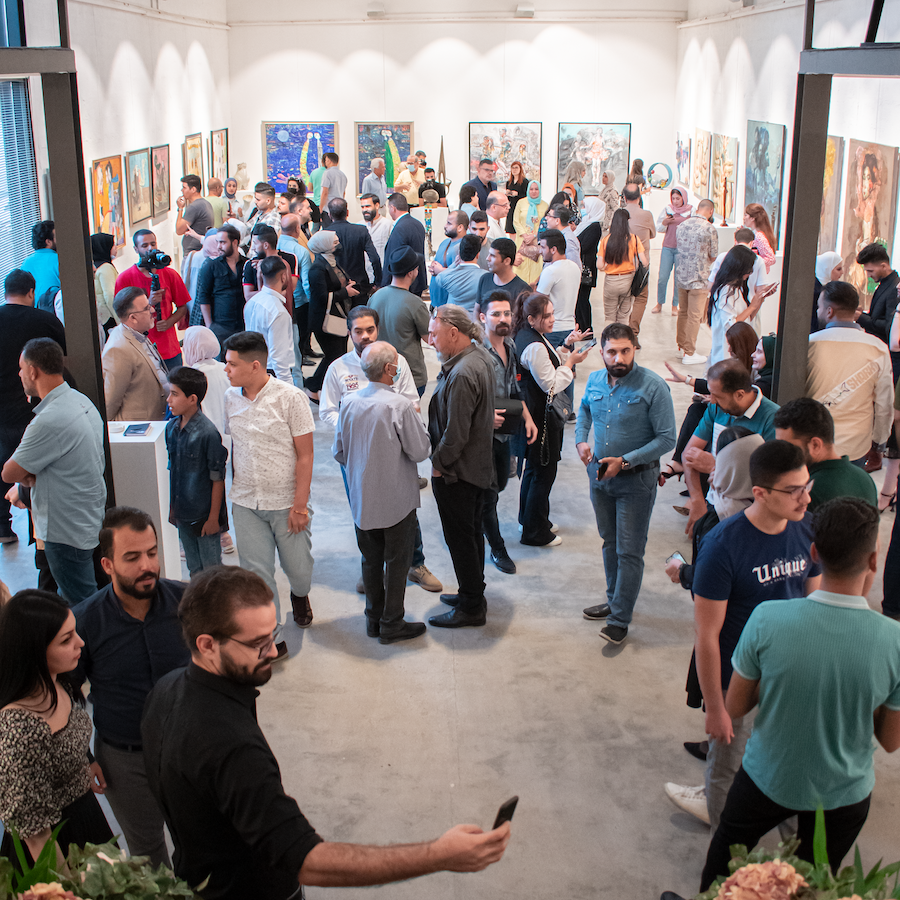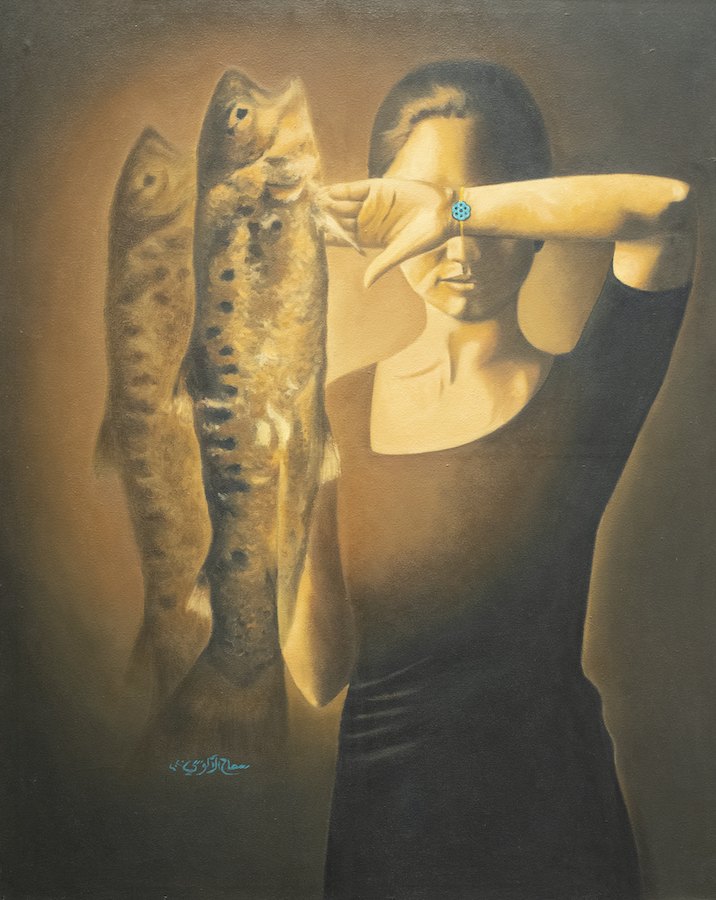DUBAI: Baghdad usually makes headlines for violence, political battles, ethnic and sectarian divides, and the bloody geopolitics that have besieged Iraq for decades since the US invasion in 2003. Over recent months, however, the capital city seems to be undergoing an artistic rebirth, with new galleries, festivals, theatre performances, the renovation of Al-Mutanabbi Street — the site of the city’s famed book market, and more.
The revamp of Al-Mutanabbi Street — revealed at the end of December — financed by private-sector banks is perhaps the most obvious sign of regeneration. The street — named after the 10th-century poet Abul Tayeb Al-Mutanabbi — has long been a place where Iraqi cultural elites would gather, ever since its inauguration in 1932 by King Faisal I. It was also the site of the massive youth-led anti-government protests in 2019, which resulted in a violent crackdown — protests which also led to the creation of more art.
Cultural performers and musicians came out to celebrate while colorful fireworks lit up the sky at December’s unveiling of the new-look street. And while high-level security surrounded the scene — reminding visitors of the country’s still-fragile state of corruption, poverty and violence — this new look and feel for the cultural heart of the Iraqi capital proves that the seeds for a cultural rebirth are there.

The graffiti mural reads ‘Humanity is present in the conscience of the paramedics,’ 2019. (GettyImages)
“Because of everything happening in Iraq now, I think it’s a great place for an artist to be inspired and explore working in a variety of media,” Amir Hazim, an Iraqi photographer based in Baghdad, tells Arab News. “However, since the invasion, many Iraqis don’t see the importance of art and its ability to make a change in the world. We have been pushed away from art. We were distracted by the problems in our country.”
Hazim tells how the 2019 protests gave Iraqi artists a chance to engage more with the outside world and “rebuild our scene again.” His photographs from the protests were shown as part of “All I Want Is Life,” a group show at Dubai-based Gulf Photo Plus, in 2020.
Any sign of cultural growth in Iraq inevitably brings to mind Baghdad’s rich artistic history: The city was considered one of the world’s cultural capitals from the 7th to 13th centuries CE during the Golden Age of Islam, and as a Middle Eastern artistic hub from the 1940s until the late 20th century. In the years that followed the 2003 invasion, though, many of its theaters, galleries and other cultural centers were destroyed.
“In 2003, all art institutions collapsed, and almost all professional art teachers and established artists fled into exile, including myself in November 2006,” renowned Iraqi artist Henaa Malallah tells Arab News. “I call it a traumatized art scene. And now, after years of violence and isolation, the scene is more complicated and much weaker. There is a great need for serious research to better understand what has become of the Iraqi art scene.”

The revamp of Al-Mutanabbi Street was revealed at the end of December. (Supplied)
Malallah is currently presenting “Co-Existent Ruins: Exploring Iraq’s Mesopotamian Past through Contemporary Art,” at SOAS’s Brunei Gallery in London through March 19, an exhibition featuring the work of Iraqi artists Rayah Abd Al-Redah; Betoul Mahdey; Fatima Jawdat and Rozhgar Mustafa.
This is by no means the first attempt to revive the Iraqi capital. In 2013, Baghdad was named the capital of Arab Culture, but most of the projects planned to mark that event were never finished, including the Al-Rasheed theater in the central part of the city. But this time round, things seem to be different, thanks to private initiatives and investments.
“People are tired of living in misery. Art gives them hope,” says Ahmed Sabti, 32, a graphic designer and manager of Hewar Art Gallery — one of Baghdad’s longest-running modern and contemporary galleries, opened in 1992 by Qasim Sabti, Ahmed’s father, an artist and collector.
“Former governments always supported art in Iraq, but sadly — after the 2003 war — there hasn’t been any support for artists or art initiatives,” Sabti tells Arab News.
Even Saddam Hussein, during the sanctions imposed by the United Nations Security Council on Ba’athist Iraq in the 1990s, would give artists money “to buy materials and make exhibitions,” adds Sabti. “Thousands of artists left Iraq after the war and galleries closed. But now we are experiencing some change.”
“We want to support Iraqi artists and show a different side to the country,” Noor Alaa Al-Din, director of The Gallery, an art space that opened in Baghdad in October with a group exhibition of well-known Iraqi artists, told Arab News.

‘Untitled,’ Samah Alalosy, 2021. (Supplied)
The Gallery stages a new exhibition each month, but is also trying “to make exhibitions in a new multidisciplinary way, different from other galleries in Iraq.”
As Al-Din, an artist herself, notes, there are still not many art collectors based in Iraq. Most of their buyers come from abroad.
“We are trying to support artists in different ways, selling their work through Instagram or our website,” she says. “We try and make our artists like stars, by taking videos and pictures of them and posting them on social media.”
Over the last few decades, while the world focused on the violence and despair gripping the capital, the stories of its artists went uncovered. International media and the art world would generally focus on the many Iraqi artists living in exile.
“Often when we think of Iraq’s art scene, we think of accomplished artists who live in Jordan, Lebanon, the UAE or the West, but we forget that there is a vibrant art scene in Baghdad that has manifested itself over the past few years, especially when one considers the art that emerged during the 2019 protests,” Emirati art patron Sultan Al-Qassimi tells Arab News.
The recovering cultural scene in Baghdad also offers a portal through which to better understand the Iraqi people, particularly the youth.
As Al Qassimi puts it: “Art is one way we can connect with Iraqi youth to learn not only about their concerns but also about their dreams and aspirations.”
The roots of a new beginning are certainly there for Baghdad’s cultural scene, but only time will tell if this growth can transcend the country’s complex socio-economic and political reality.











